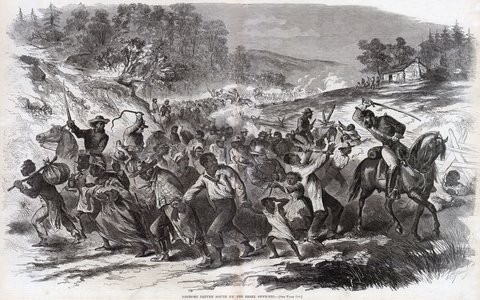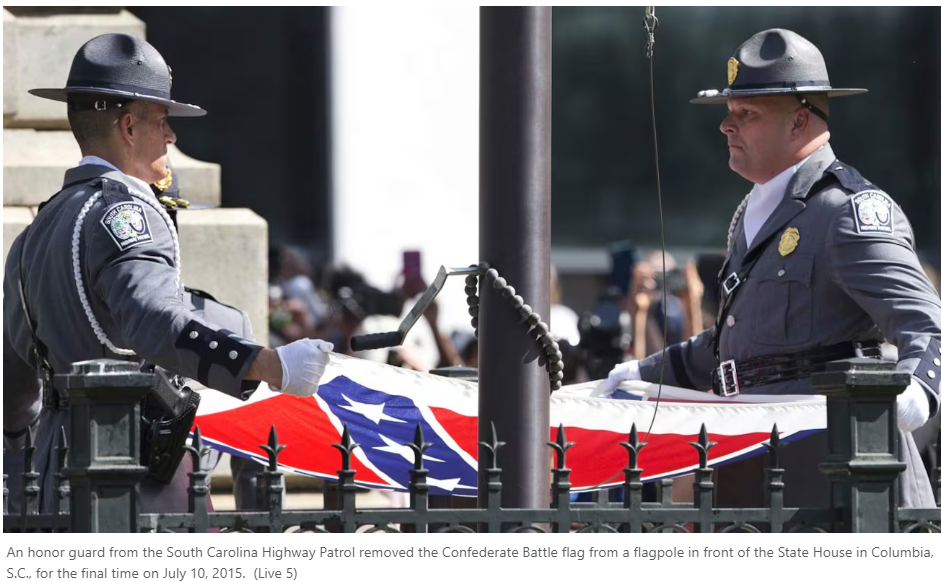Civil War historians are apt to recite one well-known fact about the battle of Gettysburg—that despite the immense carnage which blanketed the fields outside of the small Pennsylvania borough, the Civil War’s bloodiest battle surprisingly produced just one civilian fatality: Mary Virginia (“Jennie” or “Ginnie”) Wade, a young woman killed by a stray bullet in her back as she was baking bread.
While the story reminds us of the dangers facing civilians who found themselves caught between Union and Confederate forces, it also feeds into a misleading, though common narrative about the Gettysburg Campaign. It implies that violence was limited to the battlefield and the immediate vicinity, and suggests that Wade’s death marks the one, isolated instance in which a Northern civilian came into harm’s way during the 1863 invasion.
For the 5,000-plus African American residents of Adams, Cumberland, Franklin and York counties, the violence of Robert E. Lee’s invasion was anything but constrained. As soon as Brig. Gen. Albert Gallatin Jenkins’s brigade of Virginia cavalry, the vanguard of Lee’s army, entered Franklin County, the Southern horsemen began seizing any and all African Americans they encountered. In Greencastle, town councilman Charles Hartman observed Jenkins’s men “scouring the fields about town” for black residents who had concealed themselves in outlying wheat fields. “Many of them were caught after a desperate chase and being fired at,” Hartman recorded.[1]

The November 8, 1862 edition of Harper’s Weekly depicted a similar Confederate “slave hunt” during the Antietam Campaign. (House Divided Project, Dickinson College)
Similar heartrending scenes transpired throughout Franklin County, the area first traversed by the oncoming Confederate columns. In Chambersburg, Rachel Cormany watched in muted horror as Jenkins’s cavalrymen seized many of her African American neighbors. “O! How it grated on our hearts to have to sit quietly & look at such brutal deeds,” Cormany confided in her diary. Revealingly, she noted a number of freeborn black Pennsylvanians amongst the “droves” of captives—numbering between 25-50, and mostly women and children—being marched through town.[2]
Later, on June 26, Capt. John H. McNeill’s group of mounted Southerners rode into Mercersburg, a small town situated along Franklin County’s western limits. McNeill’s men quickly launched “a regular slave-hunt,” recorded Dr. Philip Schaff, one of the town’s theologians, “which presented the worst spectacle I ever saw in this war.” After threatening to torch “every house which harbored a fugitive slave, and did not deliver him up within twenty minutes,” McNeill and his coterie of horsemen forced their way into any “suspicious” homes, seizing several African Americans, including “a woman and two little children.”
Schaff counted twenty-one black civilians seized by McNeill’s Confederates, who “claimed all these negroes as Virginian slaves.” However, like Cormany in Chambersburg, Schaff was certain “that two or three were born and raised in this neighborhood.” One man, named Sam Brooks, had been employed by Schaff in splitting cords of wood for some time. When the Mercersburg minister pressed one Confederate about the legitimacy of seizing African Americans without bothering to ascertain their legal status, the Southern horseman confidently retorted that “they were only reclaiming their property which we had stolen and harbored.”[3]
Attempts to seize black residents could turn violent at any moment. Chester K. Leach of the 2nd Vermont Infantry, part of John Sedgwick’s Sixth Corps, observed the aftermath of one such confrontation, writing home, “I saw a sight yesterday that beats all I ever saw.” A black man who refused to “go over the river” with Confederate forces during the retreat became the target of a brutal assault. As punishment for resisting, “his breast & bowels were scratched or cut” and “his privates had been cut off.” Leach was among a throng of curious Army of the Potomac infantrymen who crowded into a barn to gawk at the suffering man, who “lay on his back, his legs bent, knees up, & grating his teeth” from the pain.[4]
Members of the Confederate high command were well aware of the rampant slave catching, as historian David Smith has aptly demonstrated in his essay “Race and Retaliation” (2005) and his subsequent book On the Edge of Freedom (2012). Maj. Gen. George Pickett’s division of Virginia infantry was late in reaching the battlefield, in part because the Confederate infantrymen were busy near Chambersburg guarding African American captives, whom they referred to as “contrabands.” Around mid-morning on July 1, Longstreet’s staffer G. Moxley Sorrel fired off a missive to Pickett, directing him to move his division eastward. “The captured contrabands had better be brought along with you for further disposition,” Sorrel instructed, demonstrating that Longstreet and other high-ranking Confederates were aware and complicit in the army’s seizure of black Pennsylvanians.[5]
By a conservative estimate, Lee’s army likely seized at least several hundred black Pennsylvanians during the campaign. The fate of these civilian captives remains largely unknown. Some were reportedly parceled out to slave owners, such as the family of Lucy Buck in Winchester, Virginia. Still others were sent on to Richmond, held at prisons such as Castle Thunder, and put to manual labor. While at least one of the captives was eventually released (a free black man from Mecersburg named Amos Barnes), Confederate Assistant Secretary of War John A. Campbell noted that the Confederate War Department had settled upon “an exceptional policy with regard to him.” (Barnes had allegedly helped Confederates track down and locate fugitive slaves near Mercersburg). However, for the vast majority of Pennsylvania blacks swept up by Lee’s army, there was no such reprieve.[6]
The “slave hunt” has not gone unnoticed by scholars, yet it remains largely outside the standard narrative of the Gettysburg Campaign.[7] When I relate the episode to audiences filled with local history enthusiasts or hardcore Civil War buffs, I usually get the same response—shock and astonishment. In sum, I would encourage historians to work to incorporate the harrowing experience of Pennsylvania’s African American residents into the popular understanding of the Gettysburg Campaign. Too often relegated to a footnote or merely mentioned in passing, it’s a story that absolutely needs to be told.
[1] Charles Hartman Diary, June 22, 1863, Philip Schaff Library, Lancaster Theological Seminary.
[2] Rachel Cormany Diary, June 16, 1863, Valley of the Shadow Project, [WEB].
[3] Philip Schaff Diary, June 25-27, 1863, in The Woman’s Club of Mercersburg, Old Mercersburg, (New York? The Frank Allaben Genealogical Company, 1912), 163-165, [WEB].
[4] Chester K. Leach to Dear Wife, July 15, 1863, in Edward J. Feidner (ed.), Dear Wife: The Civil War Letters of Chester K. Leach, (Burlington, VT: University of Vermont, 2002), 158.
[5] U.S. War Department, The War of the Rebellion: A Compilation of the Official Records of the Union and Confederate Armies, (Washington, DC: Government Printing Office, 1881-1901), ser. 1, 51:2, 732-733, [WEB].
[6] Jacob Hoke, Reminiscences of the War; or Incidents which transpired in and about Chambersburg, (Chambersburg, PA: M.A. Foltx, 1884), 144, [WEB]; For more detail and additional primary sources on the fate of African American captives, see this post on Amos Barnes.
[7] For the best treatments to date on the “slave hunt” and its broader ramifications, see Stanley Harrold’s Border War (2010) and David G. Smith’s On the Edge of Freedom (2012).
Cooper Wingert is a historian of the 19th century U.S., focusing on the Civil War, slavery and emancipation. The author of 12 books and numerous articles, his most recent work explores the Underground Railroad and the enforcement of the controversial 1850 Fugitive Slave Law. Previously, his book The Confederate Approach on Harrisburg(History Press, 2012) received the Dr. James I. Robertson, Jr. Literary Prize for the best work in the field of Confederate history, military, political and social. As an undergraduate, Wingert was the recipient of Dickinson College’s William Lenox Avis Prize in U.S. History, and the University of Queensland’s Thomas Morrow Prize in the field of Australian history. He is currently taking his PhD in History at Georgetown University.
–emergingcivilwar.com




